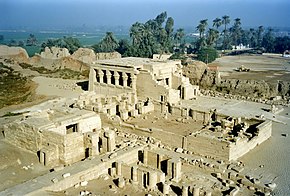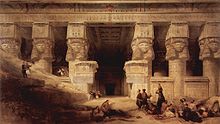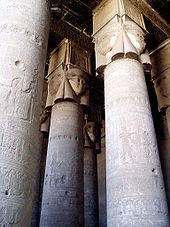Dendera
| Dendera in hieroglyphics | ||||||||
|---|---|---|---|---|---|---|---|---|
|
||||||||
Tantarer / Taentem T3 n trr / T3 n tm Dendera |
||||||||
IUNET JWNT Dendera |
||||||||
| Greek | Tentyris, Tentyra | |||||||
| Coptic | Tent gates | |||||||
| The temple complex at Dendera | ||||||||
Location in Egypt |
Dendera (also Dendara , Dandara , Dendrah ; ancient Egyptian Iunet , Tantarer , Taentem ; Greek Τέντυρα Tentyra ; Arabic دندرة, DMG Dandara ) is a place in the Upper Egyptian governorate Qina with an archaeologically important Hathor temple.
Dendera is just over 55 km north of Luxor on the left bank of the Nile opposite the city of Kena ( Kene ) on the edge of the desert. The ruins of the ancient Egyptian city are located near the place on the edge of the desert on a mountain level.
history
The history of the place began in predynastic times . This is documented by an ancient cemetery not far from the walls around the Hathor Temple.
Dendera was the capital of the sixth district of Upper Egypt , the local goddess was Hathor . The plan of the main temple goes back to Cheops . Pepi I later restored her temple.
By the time the excavations began, the temple was half sunk in the desert sand, which saved many of the frescoes from iconoclasm and vandalism . The upper rooms were used as stables and dwellings with open fireplaces, which is why the ceilings are still blackened and the former painting cannot be reconstructed.
ruins
necropolis
Behind the city, in the desert, there is an extensive cemetery. Various excavations here brought mainly large mastabas from the late Old Kingdom and the First Intermediate Period . These tombs were partially richly decorated with inscriptions and are a valuable source for this period. Other tombs date from the Ptolemaic and Roman times .
Temple of Dendera
Enclosing walls
Originally there were three enclosing walls in the district of the goddess Hathor, of which only the one for the great Hathor temple is well preserved. It is a little more than 290 m long and 280 m wide, has a base width between 10 and 12 m and reaches a height of 10 m.
Hathor Temple
A temple dedicated to Hathor is particularly famous ; it was built at the time of the 6th Dynasty and was later rebuilt. It is oriented north-south and oriented towards the Nile. It received its visible form, as a copy of the ancient sanctuary , under the last Ptolemies and first Roman emperors . Construction work on the temple began under the Ptolemies and was not completed until the Romans .
The building, which has been completed for 200 years, is well preserved and distinguished by the uniqueness of the architecture and the richness and neat execution of the sculptures and hieroglyphs . Walls and columns are entirely covered with fine sculptures. The wall sculptures inside are the victims darbringenden Emperor Augustus , Tiberius , Claudius and Nero is in the ancient Egyptian style.
The path leads through the portal into an imposing hall begun under Augustus and completed under Nero, which is supported by 24 columns in four rows and is 27.5 m high and 43 m long inside. This is followed by three rooms of various sizes and surrounded by eleven cells Adyton . The whole temple has a length of 81 m and is 34 m wide. The excavation of the Hathor temple began in 1875 by Johannes Dümichen .
Sanctuary of Isis and Mammisi
Next to the western corner of the large building is a small sanctuary of Isis , completed under Nero , to whose pylons a dromos 170 paces long led. 90 paces north of the sanctuary of Isis is the Mammisi (birthplace) dedicated to Hathor , formerly incorrectly called Typhonium .
Other plants
To the west of the temple is the Holy Lake, which is overgrown with palm trees. The underground tunnel to the Nile is still intact and the water level can be checked in one of the two tunnel accesses, which is why this facility is also known as the Nilometer .
Behind the great Hathor Temple are the Temple of Isis and the Typhonia. The Isis Temple is very small and stands behind the western corner of the Hathor Temple. It was built and decorated under Augustus. The second, larger temple is to the north of the Hathor Temple and was built under Trajan . Some representations there date from the time of Hadrian and Antoninus Pius .
Questionable "light bulbs" from Dendera
Controversial speculation was triggered by a group of unusual representations of cult objects, usually referred to only as "Dendera lightbulbs", which can be seen in several places in the Temple of Hathor.
Frontier scientific speculations dealt with the question of whether the ancient Egyptians might already be familiar with electric light in the form of incandescent lamps. In Egyptology , the motif of the "God on the flower" is seen in the representations.
Zodiac of Dendera
On the ceiling of the hall of the main temple during Napoleon's expedition, in addition to the gigantic figure of the sky goddess Nut (hence also called the heavenly hall ), two famous zodiac circles were found, one of which was sawed out by a French in 1820 and in the Egyptian section of the Louvre since 1822 is exhibited in Paris . France later had a copy made for Egypt.
On this zodiac, the lion appears as the initial sign after the intersection of the ecliptic and the earth's equator . The location of the solstice (solstice) , however, depends on the location of these intersection points and must always be in the middle of both. On the zodiac of Dendera it is recorded in Cancer . From this deviation from the current position of the sun , the scientists believed that they could infer the age of this zodiac. There was only one difference, depending on whether that solstice was viewed as a winter or summer solstice.
The controversy over this has given rise to various claims, such as: B. Fourier the origin of the same between 2500 BC. BC and 2100 BC BC, Lalande around 1300 BC BC or 1200 BC BC, Biot not before 716 BC BC and Visconti not before 328 BC Chr. Sets. The discoveries of Jean-François Champollion put an end to this speculation.
According to the Louvre, it is dated 51 BC. Estimated when Ptolemy XII. (Theos Philopator Philadelphos Neos Dionysos) put it on again, as the crypts of the lower house show. The representations come partly from the reign of Queen Cleopatra , who is shown on the outer rear wall of the temple together with her son Caesarion in a 4 m high figure.
The vestibule of the temple, which contains the second zodiac, was built between 32 and 37 AD by the residents of Tentyra under Emperor Tiberius . The wall sculptures of the rear temple were made in the reign of Cleopatra and Augustus , those of the Pronaos under Tiberius, Caligula , Claudius and Nero.
See also
literature
- Dieter Arnold : Die Tempel Ägyptens , Bechtermünz, Augsburg 1996, pp. 164–168, ISBN 3-86047-215-1 .
- Dieter Arnold: Dendera , in: Lexikon der ägyptischen Baukunst, Artemis & Winkler, Zurich 1997, ISBN 3-7608-1099-3 , pp. 64–66.
- Mariette Auguste: Dendérah: description générale du grand temple de cette ville , 5 vols., 1870–1874 online
- Hans Bonnet: Dendera , in: Lexikon der ägyptischen Religionsgeschichte , Hamburg 2000 ISBN 3-937872-08-6 p. 155f.
- Sylvie Cauville, Anni Gasse: Fouilles de Dendara , in: Bulletin de l'Institut français d'archéologie orientale, No. 88, Cairo 1988 ISSN 0255-0962
- Sylvie Cauville: Le temple d'Isis à Dendera , in: Bulletin de la Société française d'égyptologie, No. 123, Paris 1992.
- Sylvie Cauville: Dendera. In: Kathryn A. Bard (Ed.): Encyclopedia of the Archeology of Ancient Egypt. Routledge, London 1999, ISBN 0-415-18589-0 , pp. 252-54 ..
- E. Winter: A Reconsideration of the Newly Discovered Building Inscription on the Temple of Denderah , in: Göttinger Miszellen , No. 108, Göttingen 1989 ISSN 0344-385X .
Web links
- Virtual tour through the Dendera Temple ( Memento from December 24, 2001 in the Internet Archive ) []
- Photo travel report
- A New Interpretation of the Dendera Zodiac (English, excerpt from "Babylonian Star-Lore, An Illustrated Guide to the Star-lore and Constellations of Ancient Babylonia" by Gavin White) ( Memento from October 9, 2011 in the Internet Archive )
Coordinates: 26 ° 9 ′ N , 32 ° 40 ′ E







